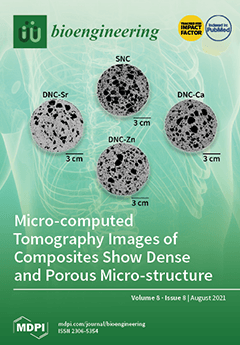Open AccessArticle
Modulation of Synthetic Tracheal Grafts with Extracellular Matrix Coatings
by
Lumei Liu, Sayali Dharmadhikari, Robert A. Pouliot, Michael M. Li, Peter M. Minneci, Zhenghong Tan, Kimberly Shontz, Jed Johnson, Susan D. Reynolds, Christopher K. Breuer, Daniel J. Weiss and Tendy Chiang
Cited by 4 | Viewed by 2484
Abstract
Synthetic scaffolds for the repair of long-segment tracheal defects are hindered by insufficient biocompatibility and poor graft epithelialization. In this study, we determined if extracellular matrix (ECM) coatings improved the biocompatibility and epithelialization of synthetic tracheal grafts (syn-TG). Porcine and human ECM substrates
[...] Read more.
Synthetic scaffolds for the repair of long-segment tracheal defects are hindered by insufficient biocompatibility and poor graft epithelialization. In this study, we determined if extracellular matrix (ECM) coatings improved the biocompatibility and epithelialization of synthetic tracheal grafts (syn-TG). Porcine and human ECM substrates (pECM and hECM) were created through the decellularization and lyophilization of lung tissue. Four concentrations of pECM and hECM coatings on syn-TG were characterized for their effects on scaffold morphologies and on in vitro cell viability and growth. Uncoated and ECM-coated syn-TG were subsequently evaluated in vivo through the orthotopic implantation of segmental grafts or patches. These studies demonstrated that ECM coatings were not cytotoxic and, enhanced the in vitro cell viability and growth on syn-TG in a dose-dependent manner. Mass spectrometry demonstrated that fibrillin, collagen, laminin, and nephronectin were the predominant ECM components transferred onto scaffolds. The in vivo results exhibited similar robust epithelialization of uncoated and coated syn-TG patches; however, the epithelialization remained poor with either uncoated or coated scaffolds in the segmental replacement models. Overall, these findings demonstrated that ECM coatings improve the seeded cell biocompatibility of synthetic scaffolds in vitro; however, they do not improve graft epithelialization in vivo.
Full article
►▼
Show Figures






